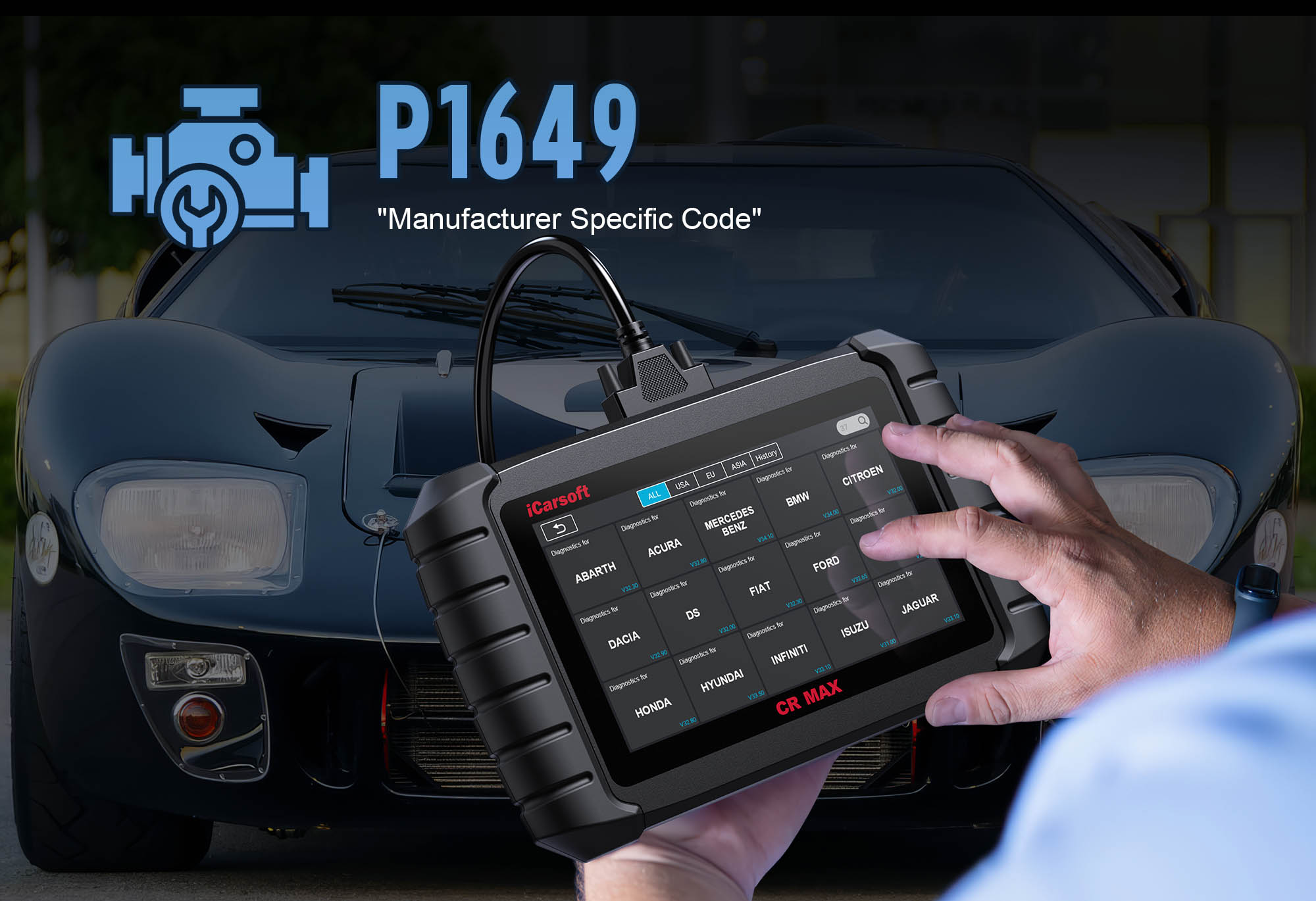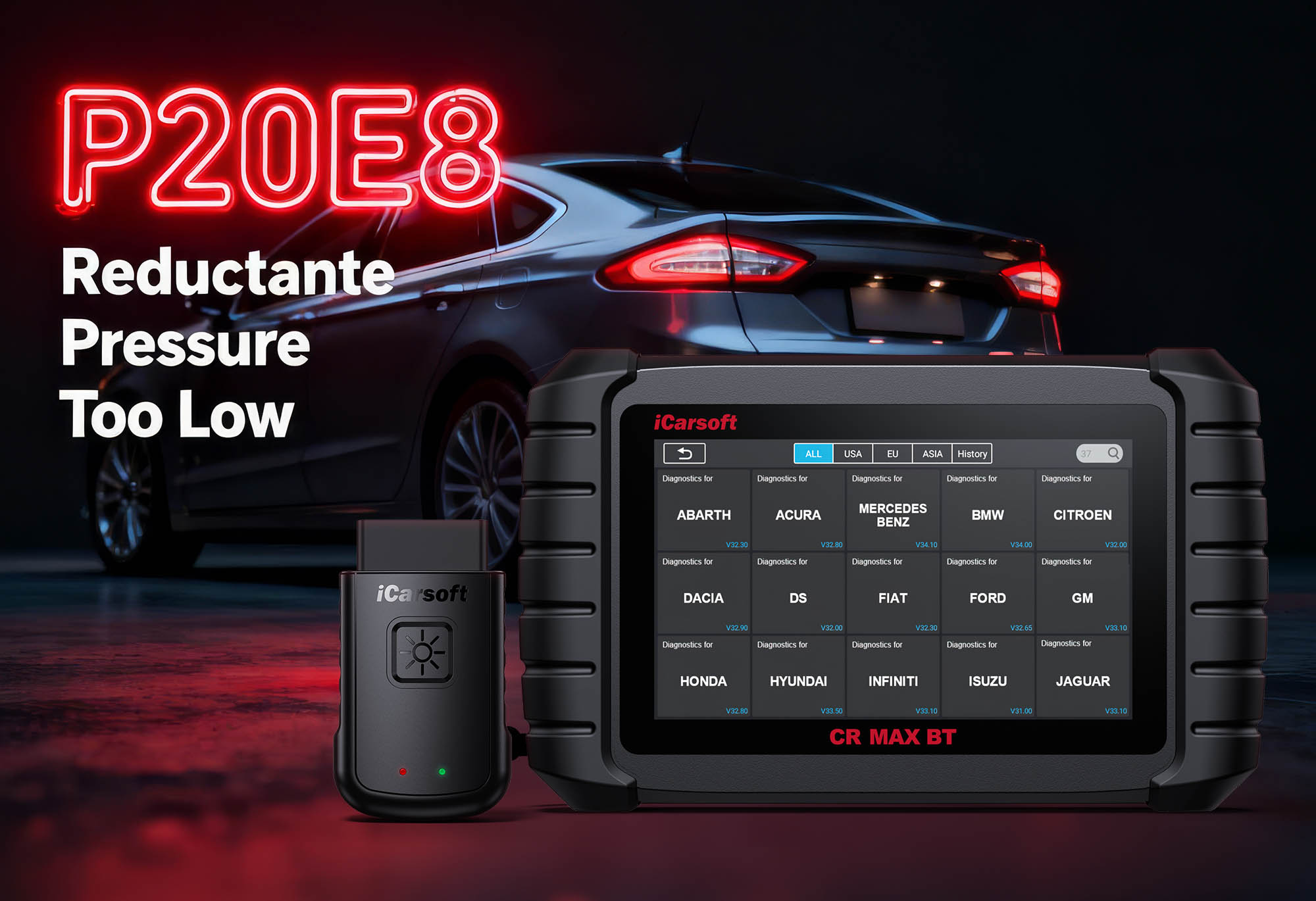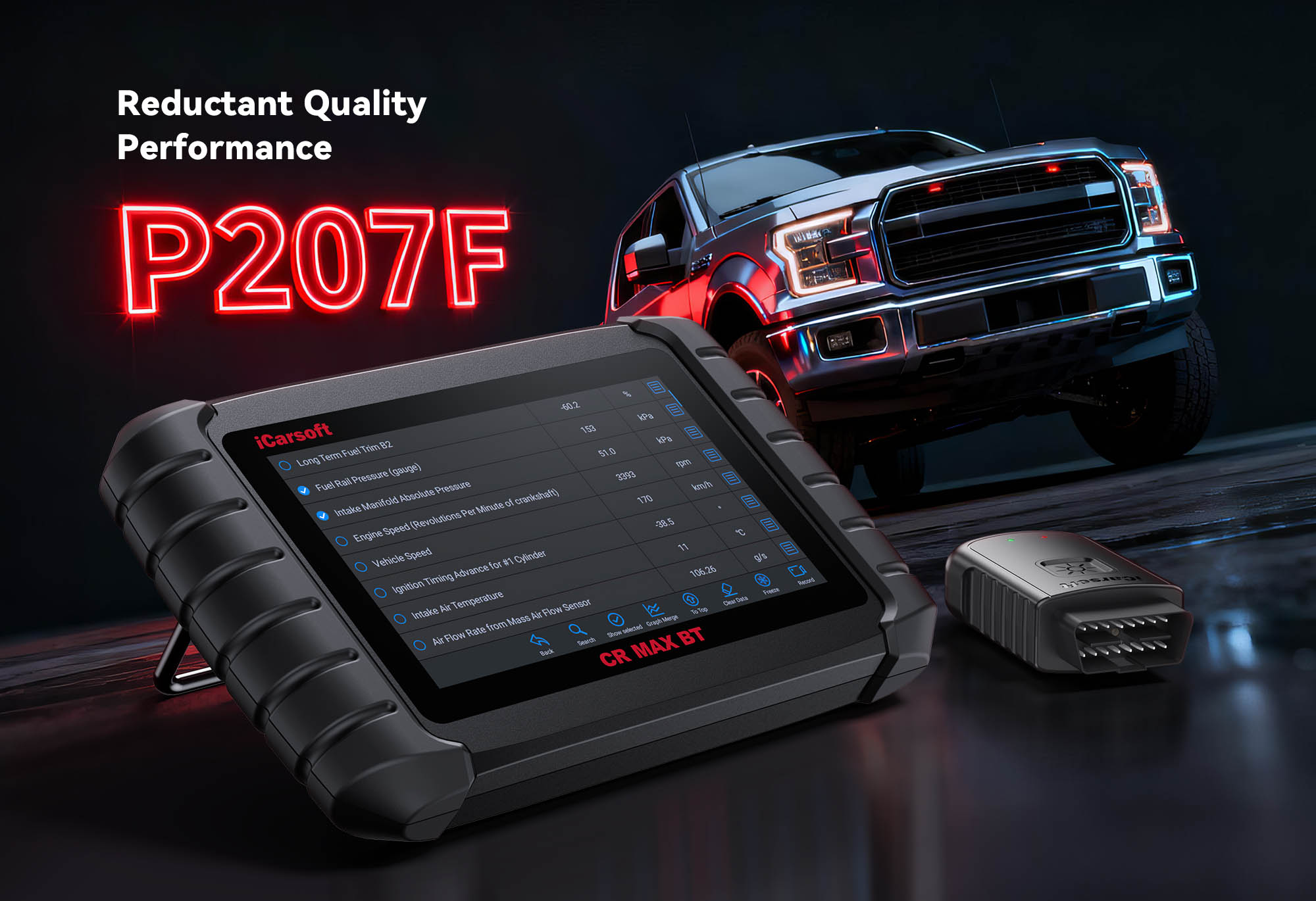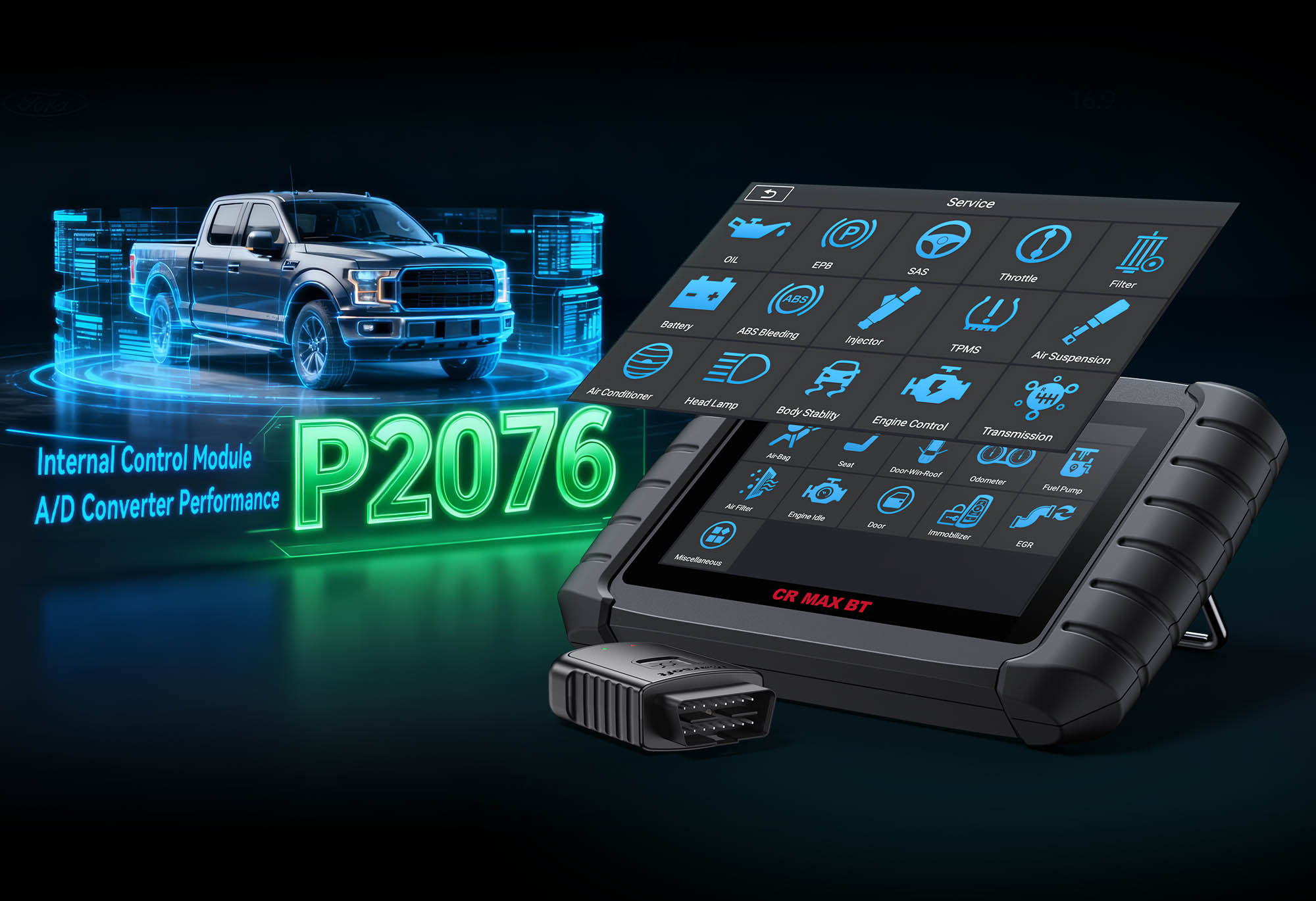P1649 Code: EVAP Purge Solenoid Circuit Fault – What It Means & How to Fix It (iCarsoft CR MAX Guide)
If you drive a FCA Group vehicle (Chrysler, Jeep, Dodge, Ram) and your check engine light illuminates, a scan revealing code P1649 points to a critical issue in the evaporative emission (EVAP) system—specifically the purge solenoid control circuit. Unlike generic EVAP codes (e.g., P0440), P1649 is manufacturer-specific, defined as either “EVAP Purge Solenoid Control Circuit Open” or “Purge Solenoid Performance Fault” (varies by FCA model). Left unaddressed, it can cause failed emissions tests, reduced fuel efficiency, and rough idling—all while keeping your check engine light on.
Basic scanners may read P1649 but lack FCA-specific data to pinpoint the root cause (faulty solenoid, broken wiring, or ECM glitch). The iCarsoft CR MAX solves this: preloaded with FCA’s EVAP system specs, bi-directional solenoid testing, and advanced circuit diagnostics, it turns guesswork into precise repairs. This guide walks you through diagnosing and clearing P1649 step-by-step.
First: Understand P1649 – What It Is & Why It Matters
P1649 is not a universal code—clarity on its function and FCA-specific definitions is critical to effective repairs:
Key Context: The EVAP System & Purge Solenoid
The EVAP system captures fuel vapors from the gas tank and stores them in a charcoal canister. The purge solenoid (controlled by the Engine Control Module/ECM) opens to “purge” these vapors into the engine for combustion—reducing harmful emissions. P1649 triggers when the ECM detects a disruption in the circuit that powers or signals this solenoid.
FCA-Specific P1649 Definitions
Chrysler/Jeep
“EVAP Purge Solenoid Control Circuit Open” – The ECM detects no current flow in the solenoid’s electrical circuit (no power reaching the solenoid).
Dodge/Ram
“Purge Solenoid Performance Fault” – The solenoid does not respond as expected to ECM commands (e.g., fails to open/close when triggered).
Key Symptoms of P1649
Persistent Check Engine Light
The most obvious sign: The light stays on (not intermittent) because the ECM continuously detects the circuit fault.
Failed Emissions Tests
The EVAP system cannot properly control fuel vapors, leading to超标 emissions (a common reason for test failures in FCA vehicles).
Reduced Fuel Efficiency
Unburned fuel vapors (that should be purged and reused) are wasted, causing a slight drop in MPG (1–3 MPG in most cases).
Rough Idle (Rare)
If the solenoid is stuck open, excess fuel vapors flood the engine—causing unstable idle, stalling, or hesitation during acceleration.
Common Causes of P1649
Faulty Purge Solenoid
Internal electrical failure (e.g., burned coil, stuck valve) prevents the solenoid from activating. This is the most frequent cause of P1649 in FCA vehicles.
Broken/Shorted Wiring
Frayed wires or loose connections between the solenoid and ECM disrupt current flow. Common in areas where wiring rubs against engine components (e.g., intake manifold).
Corroded Connectors
Rust or dirt in the solenoid’s 2-pin electrical plug creates resistance, blocking signal/power transfer between the solenoid and ECM.
Blown EVAP Fuse
A dedicated “EVAP Purge” fuse (in the engine bay or interior fuse box) powers the solenoid—blown fuses cut power entirely, triggering P1649.
ECM Malfunction (Rare)
The ECM’s driver circuit for the purge solenoid fails, unable to send control signals. Only likely after ruling out all other causes.
Why iCarsoft CR MAX Is Essential for P1649
P1649’s FCA-specific nature makes generic scanners ineffective. The CR MAX excels with features tailored to Chrysler, Jeep, Dodge, and Ram vehicles:
CR MAX Features for FCA P1649 Diagnostics
FCA-Specific EVAP Data
Preloaded with exact purge solenoid specs (voltage requirements: ~12V; resistance range: 10–30 ohms) for models like Jeep Wrangler JL, Dodge Charger, and Ram 1500.
Bi-Directional Control
Manually activate/deactivate the purge solenoid to test functionality—listen for a “click” or monitor current flow to confirm if it’s stuck/dead.
Real-Time EVAP Monitoring
Track critical parameters: “Purge Solenoid Duty Cycle” (0% = off, 100% = open), “Circuit Voltage,” and “EVAP System Pressure” to spot irregularities.
Built-In Circuit Testing
Integrated multimeter checks voltage, resistance, and continuity in the solenoid circuit—no need for a separate tool.
Fuse & Component Location
Pinpoints the exact “EVAP Purge” fuse and solenoid position (via diagrams) for your FCA model—saves time on manual searching.
Step-by-Step: Diagnose P1649 with iCarsoft CR MAX
-
1. Connect CR MAX & Confirm P1649
-
Plug the CR MAX into your vehicle’s OBD-II port (under the dashboard) and power it on.
-
Select Vehicle Make > FCA Group (Chrysler/Jeep/Dodge/Ram), then your specific model/year. Use AutoVIN Recognition for accuracy (ensures FCA-specific code definitions).
-
Navigate to Engine > Fault Codes > Read Codes to confirm P1649. Note related EVAP codes (e.g., P0442 for small leaks, P0455 for large leaks)—these indicate additional issues.
-
Tap Code Details to view the exact FCA definition (e.g., “2020 Jeep Wrangler: Purge Solenoid Control Circuit Open”) and recommended first steps.
-
2. Check the EVAP Purge Fuse (Quick Fix First)
-
Go to Special Functions > Fuse Location > EVAP System on the CR MAX. The tool displays a fuse box diagram, highlighting the “EVAP Purge” fuse (e.g., 10A fuse in slot 23 for 2021 Ram 1500).
-
Locate and inspect the fuse: If blown (broken metal strip inside), replace it with a fuse of the same amperage.
-
Re-scan with the CR MAX: If P1649 clears, the fuse was the issue. If not, proceed to Step 3.
-
3. Analyze Real-Time EVAP Data
-
Navigate to Engine > Live Data > EVAP System and select these parameters:
-
“Purge Solenoid Duty Cycle” (ECM’s command to the solenoid)
-
“Purge Solenoid Circuit Voltage” (power sent to the solenoid)
-
“EVAP System Pressure” (stability indicates proper solenoid function)
-
Start the engine and warm it up (5–10 minutes, until operating temperature).
-
Observe data while the ECM cycles the solenoid (during idle/light acceleration):
-
Duty Cycle changes, but voltage stays 0V: No power to the solenoid (wiring/ECM issue).
-
Voltage present (~12V), but solenoid doesn’t activate: Faulty solenoid.
-
Voltage fluctuates randomly: Loose/corroded connector.
-
4. Test the Purge Solenoid with Bi-Directional Control
-
Navigate to Special Functions > EVAP Tests > Purge Solenoid Activation. Follow on-screen prompts (turn ignition to “On,” engine off, for safety).
-
Select Activate Solenoid (50% Duty Cycle):
-
Listen for a faint “click” (solenoid opening) and feel for vibration (if accessible).
-
Check live data: “Purge Solenoid Circuit Current” should read 0.5–1.5A (FCA normal range).
-
Interpret results:
-
No click/current: Solenoid is faulty (replace) or no power (check wiring).
-
Click/current present: Solenoid works—issue is in wiring/ECM.
-
5. Inspect Solenoid Wiring & Connectors
-
Step 1: Locate the purge solenoid via Component Location (typically mounted on the intake manifold or near the charcoal canister).
-
Step 2: Disconnect the solenoid’s 2-pin electrical connector.
-
Step 3: Test with CR MAX’s multimeter:
-
Voltage Test: Set to “DC Voltage.” Connect one probe to the connector’s “power” pin, the other to ground. Turn ignition “On”—should read ~12V. No voltage = broken wiring/fuse.
-
Resistance Test: Set to “Ohms.” Connect probes to the solenoid’s two pins. Normal range: 10–30 ohms. Infinite resistance = broken coil; <5 ohms = shorted coil (replace solenoid).
-
Step 4: Clean connectors with electrical contact cleaner—oxidation causes circuit resistance.
Repair & Verify: Clear P1649 for Good
Once you’ve identified the root cause, follow these steps to repair and confirm the fix:
-
1. Repair or Replace Components
-
Faulty Solenoid: Replace with an OEM FCA part (use CR MAX’s Part Lookup for the correct number, e.g., Mopar 68210576AA for Jeep Wrangler).
-
Broken Wiring: Repair small breaks with heat-shrink tubing; replace damaged harness sections for severe issues.
-
ECM Malfunction: Run ECM Health Check (via CR MAX) to confirm. Consult a FCA specialist for reprogramming/replacement.
-
2. Clear P1649 & Reset the EVAP System
-
Reconnect all components (solenoid, connectors, fuses).
-
Clear the code: Go to Fault Codes > Clear Codes and select P1649. Confirm deletion.
-
Run EVAP System Relearn (Special Functions > EVAP Tests > System Relearn)—resets the ECM’s EVAP adaptation data.
-
3. Verify Repairs
-
Idle the engine for 10 minutes—check for smooth operation (no rough idle).
-
Take a 30-mile test drive (mix of highway/city). Use CR MAX’s Data Logging to record EVAP parameters.
-
Re-scan after the drive: No P1649 + stable purge solenoid data = successful fix.
Pro Tip: If P1649 returns after repair, use the CR MAX’s Freeze Frame Data (under Fault Codes) to see when the code triggers (e.g., during acceleration, idle). This narrows down intermittent issues like loose wiring.
Prevent P1649 from Recurring
Use the CR MAX to keep your FCA’s EVAP system in top shape and avoid future P1649 codes:
Quarterly EVAP Health Scans
Run EVAP System Health Scan (via CR MAX) to test solenoid response and circuit integrity—catch issues early.
Inspect Wiring During Tune-Ups
Check purge solenoid wires for wear (especially near hot components like the exhaust manifold) to prevent fraying.
Test the Gas Cap
Use CR MAX’s Gas Cap Test to check seal integrity. A loose/faulty cap strains the purge solenoid, increasing P1649 risk.
Update ECM Software
The CR MAX checks for FCA’s latest ECM updates—some P1649 cases are fixed with software patches.
Can I Drive with P1649?
Yes, but with caution—and only temporarily. Here’s why:
-
Emissions Risk: You’ll fail state emissions tests, leading to fines or registration issues.
-
Fuel Waste: Reduced efficiency means more frequent trips to the gas station.
-
Escalating Damage: A faulty solenoid or wiring can strain the ECM over time, leading to costlier repairs ($500+ for ECM replacement).
-
Rough Idle Risk: If the solenoid is stuck open, rough idling or stalling may occur—unsafe in traffic.
Fix P1649 within 1–2 weeks of detection. Avoid long drives until the issue is resolved.
Summary Table: P1649 Diagnosis Workflow (CR MAX-Powered)
|
Step
|
Action with iCarsoft CR MAX
|
Goal
|
|
1
|
Read codes + Code Details (FCA-specific definition)
|
Confirm P1649 and rule out related EVAP codes
|
|
2
|
Fuse Location > EVAP System; inspect/replace fuse
|
Fix the simplest cause of P1649 first
|
|
3
|
Live Data > EVAP System; monitor duty cycle/voltage
|
Identify power/communication issues in the circuit
|
|
4
|
Bi-Directional Test > Purge Solenoid Activation
|
Confirm if the solenoid is functional
|
|
5
|
Multimeter > Voltage/Resistance Tests; Component Location
|
Pinpoint wiring/solenoid faults
|
|
6
|
Clear Codes + EVAP System Relearn; Data Logging
|
Reset the system and verify the fix
|
Final Thoughts
P1649’s FCA-specific focus makes it a challenge for generic tools, but the iCarsoft CR MAX simplifies diagnosis and repair. By combining bi-directional solenoid testing, real-time EVAP data, and FCA-aligned circuit diagnostics, it helps you fix the root cause—whether a blown fuse, faulty solenoid, or broken wire—without wasting money on unnecessary parts.
For FCA vehicle owners and technicians, the CR MAX is the key to resolving P1649 quickly, passing emissions tests, and restoring fuel efficiency. Don’t let a stubborn check engine light slow you down—use the CR MAX to get your EVAP system back in top shape.
FAQs About P1649 Code
Q: Why is P1649 only common in FCA vehicles?
A: P1649 is a manufacturer-specific code—FCA uses unique EVAP system hardware (e.g., purge solenoid wiring layouts, ECM control logic) that differs from other brands. Generic codes (like P0443 for purge solenoid circuit) apply to non-FCA vehicles, while FCA uses P1649 for similar issues.
Q: How much does it cost to fix P1649?
A: $10–$30 for a blown fuse; $80–$200 for an OEM purge solenoid; $50–$150 for wiring/connector repairs; $100–$300 for ECM reprogramming (if needed). DIY repairs with the CR MAX save $150–$400 vs. dealer labor.
Q: Will a faulty gas cap cause P1649?
A: No—gas cap issues trigger generic EVAP leak codes (P0442, P0455), not P1649. P1649 is strictly a purge solenoid circuit fault (power/wiring/solenoid), not a leak issue. However, a bad gas cap can strain the EVAP system, increasing solenoid wear over time.
Q: Do I need to reset the ECM after fixing P1649?
A: Yes—FCA’s ECM stores EVAP system adaptation data. Use the CR MAX’s “EVAP System Relearn” function to reset this data; without it, the ECM may still detect a “fault” from old readings, causing P1649 to return.





